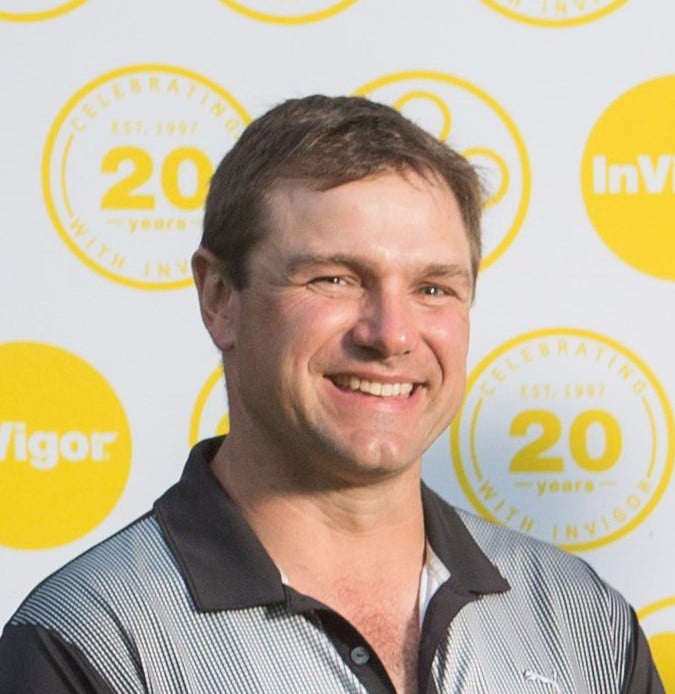InVigor hybrid canola’s second Pod Shatter Reduction variety changed the way farmers harvest their crop.
Canola designed to reduce pod shatter has changed the way farmers do business. Jeff Mansiere and Stewart Brandt are two of the BASF Canada Agricultural Solutions plant breeders they have to thank for that.
Mansiere, Brandt and their breeding team are behind InVigor L233P hybrid canola from BASF. Launched in 2017, it’s the second Pod Shatter Reduction hybrid introduced by BASF and has been grown on more than 20 million acres across Canada. In both 2019 and 2020, InVigor L233P made up more than a quarter of the canola acres planted in Western Canada.
As a result, InVigor L233P has been selected by Germination‘s editorial board as the 2021’s Seed of the Year — the first canola to win the honour in the award’s history.
“InVigor L233P was our opportunity to get a Pod Shatter Reduction hybrid into the hands of growers so they could experience the benefits,” Brandt says. “It did all that and more. As a plant breeder, you don’t ever expect a hybrid will become as popular as InVigor L233P has become. To say it had an impact would be an understatement.”
It is expected that by the end of the 2021 crop season, InVigor L233P will surpass InVigor 5440 for the most acres of InVigor grown by a single InVigor hybrid. The hybrid won the Canola Performance Trials (CPTs) straight cut trials in 2018 for the highest yield when averaged across all the growing zones.
By allowing canola seeds to fully mature while the crop is standing, Pod Shatter Reduction technology has been shown to increase yields by as much as five per cent in internal trials. It’s also made straight cutting canola far more practical. But perhaps most significantly, pod shatter reduction technology allows for more flexibility at harvest, as farmers can wait for the crop to evenly mature and not worry about the plants shedding their seed.
Kristjan Hebert knows these benefits well. The managing partner for Hebert Grain Ventures in Moosomin, Sask., first grew InVigor L233P in 2016 as a plot.
“What it allows us to do, even when we’re going to swath, is give the canola a lot more time to mature across the whole field. Straight cutting is another great tool to have in the toolbox and Pod Shatter Reduction technology really makes that possible,” he says.
“If I kind of had that ‘wow’ moment when your face looks like a little kid, it was probably the first time we straight cut InVigor L233P. You look in the hopper, and you really see the difference in the colour and the size of the canola seeds with straight cut canola versus swathed canola. They’re just a darker black or purple colour and really big. They almost look like BBs. That ‘wow’ moment is probably the best part of using a new technology in agriculture and being impressed with it.”

Taking a Crop to the Next Level
InVigor L233P was developed and selected on the learnings from a previous Pod Shatter Reduction hybrid called InVigor L140P.
“We started with really focusing on a product that had to be robust, had good strength and yield performance, and broad geographic stability. It couldn’t just perform in one geographic region, but had to perform across Western Canada,” Mansiere says.
“Maturity and lodging resistance were a couple targets that we were trying to improve. We wanted to make it a little bit more user friendly, giving growers flexibility in how they approach their harvest.”
InVigor L233P ended up fitting the bill, but at first they didn’t know just how well.
“InVigor L140P really set the bar. It gave us commercially acceptable shatter tolerance, so in creating what became InVigor L233P we really paid a lot of attention also to selecting for improved parental lines. On the male side of development, we had already started to begin doing forward breeding and started focusing on yield enhancement, improved combining ability and better lodging tolerance,” Brandt adds.
“We were pretty confident we’d be able to make an improvement over InVigor L140P in some important areas, but at the time we just didn’t know how much better InVigor L233P would actually end up being. Its wide acceptance surprised many of us.”
The end of 2021 will mark five years that InVigor L233P hybrid canola has been on the market. By then it will have been grown on more than 21 million acres in Canada, notes BASF Canada Canola Seeds and Traits Manager Wade Stocker.
“To put that in perspective, over the last two years, this one hybrid has comprised more than 30 per cent of the entire canola acres in Western Canada. That is pretty much unparalleled. It puts into perspective how quickly and how significantly this hybrid has penetrated the Canadian marketplace, the canola marketplace, and what it’s meant to canola growers and how they harvest,” Stocker says.
“In 2014, prior to the introduction of the InVigor Pod Shatter Reduction hybrids, very little canola was straight cut. By 2020, close to half of the canola in Western Canada was straight cut thanks to this technology.”
Stocker notes the benefits of pod shatter reduction technology go beyond just harvest.
“It’s led to savings in fuel, emissions and resources, and as the market shifts from swathing to straight cutting canola it has helped growers manage their time and labour,” he says.
When InVigor L233P was launched, the associated marketing campaign made use of a social media hashtag, #SellTheSwather, which Stocker says represented a change in the way BASF used social media and how hybrid canola is marketed.
“Obviously, not everyone ran out and sold their swather just because of InVigor pod shatter reduction technology, but that wasn’t the point. The point was to have a fun conversation and get engagement from growers and in the industry, and we definitely did that.”
For Mansiere, who grew up on a mixed farm in northeast Saskatchewan, it’s been surreal to see InVigor L233P take off like it has.
“It’s been very, very humbling to see it be this successful on an acreage basis. As a breeder you can only hope one of your hybrids will have just some of the impact that this one has,” he says.
Brandt, whose family owns a Centennial farm in southern Saskatchewan, says the quest to develop the perfect product still goes on.
“You hope that the next product you come out with brings value to your customers and delivers solutions. That’s what every breeder focuses on and that’s what I would expect the next products that come out of our program will deliver. We have to deliver that as breeders — it’s our job. It’s a big challenge, but it’s what we all sign up for when we get into this.”











